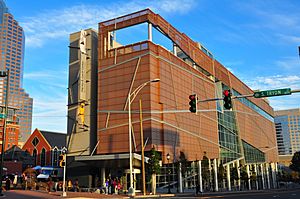Harvey Gantt facts for kids
Quick facts for kids
Harvey Gantt
|
|
|---|---|

Gantt as a Clemson student c. 1964
|
|
| 50th Mayor of Charlotte | |
| In office 1983–1987 |
|
| Preceded by | Eddie Knox |
| Succeeded by | Sue Myrick |
| Personal details | |
| Born |
Harvey Bernard Gantt
January 14, 1943 Charleston, South Carolina, U.S. |
| Political party | Democratic |
| Spouse | Lucinda Brawley |
| Children | 4 |
| Education | Iowa State University Clemson University (BArch) Massachusetts Institute of Technology (MUP) |
Harvey Bernard Gantt (born January 14, 1943) is an American architect and politician. He is a member of the Democratic Party. Mr. Gantt is well-known for his work in North Carolina.
He made history as the first African-American student to attend Clemson University. After graduating with honors, he earned a master's degree from MIT. Later, he started his own architecture business in Charlotte. He also served as the first African-American Mayor of Charlotte.
Contents
Early Life and Education
Harvey Gantt was born in Charleston, South Carolina. His parents were Wilhelminia and Christopher C. Gantt. His father worked at a shipyard.
Even in high school, Harvey Gantt began working for civil rights. This meant fighting for equal rights for all people. In 1963, he transferred from Iowa State University. He then became the first African American student to be accepted into Clemson University in South Carolina.
He earned a degree in architecture with honors from Clemson. Later, he received a Master's degree in City Planning from MIT.
Political Career
Serving Charlotte
From 1974 to 1983, Harvey Gantt served on the Charlotte City Council. This council helps make decisions for the city.
In 1983, he was elected as the first African-American mayor of Charlotte, North Carolina. He served two terms as mayor, until 1987. He tried for a third term but was not re-elected. He was the last Democratic mayor of Charlotte until 2009.
Running for U.S. Senate
In 1990, Harvey Gantt ran for a seat in the United States Senate in North Carolina. He was a Democrat. He ran against the person who already held the seat, Republican Jesse Helms.
Gantt focused his campaign on important issues. He talked about jobs, education, and health care. He lost this election. He ran against Jesse Helms again in 1996. However, he lost that election as well.
After Politics
Today, Harvey Gantt runs a successful architecture firm. It is called Gantt Huberman Architects. He also continues to be involved in politics. He has served on important committees. These include the North Carolina Democratic Party Executive Council. He also served on the Democratic National Committee. He was also chosen to lead the National Capital Planning Commission in Washington, D.C.
In 2009, the City of Charlotte honored Harvey Gantt. They built the Harvey B. Gantt Center for African-American Arts + Culture. This center recognizes his important work. It celebrates his contributions to the civil rights movement. It also honors him as Charlotte's first black mayor. The building is large and cost $18.6 million to build. It is part of the Levine Center for the Arts.

In 2016, PBS Charlotte and UNC-TV featured Harvey Gantt. They included him in their online series called "Biographical Conversations." In this series, he shared stories from his life. He talked about his time at Clemson University. He also spoke about becoming Mayor of Charlotte, North Carolina.
Personal Life
Harvey Gantt is married to Lucinda (Brawley) Gantt. She was the second black student to attend Clemson University. They have four children together. Their names are Sonja, Erika, Angela, and Adam. Their daughter, Sonja Gantt, used to be a news anchor at WCNC-TV in Charlotte.
See also
- African-American architects
- List of African-American United States Senate candidates
- Civil rights activists
- African Americans in politics

